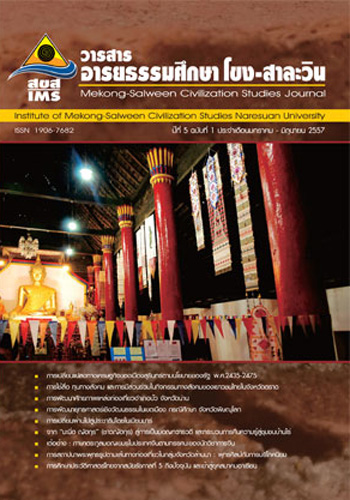จาก “มะนิ่ฮ ญัฮกุร” (ชาวญัฮกุร) สู่การเป็นมอญทวารวดี และกระบวนการคืนความรู้สู่ชุมชนบ้านไร่
Main Article Content
Abstract
ผลจากการเปลี่ยนทางด้านเศรษฐกิจและสังคมทำให้เกิดการเปลี่ยนแปลงด้านอัตลักษณ์ของชาวญัฮกุรหลายประการ บทความนี้เป็นส่วนหนึ่งของงานวิจัยในโครงการศึกษาและฟื้นฟูประวัติศาสตร์ชาติพันธุ์ละเวือะและมอญที่ได้รับการสนับสนุนจากสำนักงานสนับสนุนการวิจัย ซึ่งมีวัตถุประสงค์เพื่อจัดทำประวัติศาสตร์ชาติพันธุ์ และนำความรู้ที่ได้ไปสู่การฟื้นฟูอัตลักษณ์และส่งคืนความรู้สู่ชุมชน โดยผู้เขียนเลือกหมู่บ้านของชาวญัฮกุรที่บ้านไร่ อำเภอเทพสถิต จังหวัดชัยภูมิ มาเป็นกรณีศึกษา ด้วยเหตุผล 2 ประการหลักคือ ประการแรก ชุมชนมีความเข้มแข็งและมีผู้ช่วยวิจัยท้องถิ่นที่ทำให้งานมีความสะดวก ประการที่สอง หมู่บ้านแห่งนี้เป็นหมู่บ้านเก่าแก่ มีนิทานประวัติศาสตร์หลายเรื่อง ตั้งอยู่บนเส้นทางการค้าโบราณ และพบแหล่งโบราณคดีที่เก่าไปถึงพุทธศตวรรษที่ 16 ซึ่งอาจนำไปสู่การตอบคำถามเรื่องการเสื่อมถอยอำนาจไปของรัฐทวารวดี
ผลจากการศึกษาพบว่า ภาษาญัฮกุรมีความสัมพันธ์กับภาษามอญโบราณที่ใช้กันในรัฐทวารวดี และยังสัมพันธ์กับภาษากุยและเขมร นิทานของชาวญัฮกุรถือเป็นคลังความรู้ที่สำคัญ เพราะในชุมชนยังมีนิทานเรื่องหนึ่งที่เล่าว่าชาวญัฮกุรถูกแย่งปราสาทโดยชาวเขมร ซึ่งสามารถตีความร่วมกับหลักฐานทางโบราณคดีได้ว่าชาวทวารวดีส่วนหนึ่งอาจอพยพหนีขึ้นมายังเขตภูเขาสูงของที่ราบสูงโคราช เมื่อ 50-100 ปีก่อน ชุมชนแห่งนี้เป็นสังคมของนายพรานและคนที่ทำการค้าของป่าโดยนำผลผลิตไปแลกกับเกลือที่บำเหน็จณรงค์ ตอนหลังชุมชนได้พัฒนาเศรษฐกิจเข้าสู่สังคมสมัยใหม่ จนทำให้อัตลักษณ์ของชุมชนทั้งด้านภาษาและประเพณีเกิดการเปลี่ยนแปลงไปมาก
จากข้อมูลความรู้ทางประวัติศาสตร์ข้างต้น ผู้เขียนได้นำไปสู่การทำกิจกรรมต่างๆ เช่น การเผยแพร่ความรู้ในพื้นที่สาธารณะของชุมชน การพัฒนาประวัติศาสตร์สองภาษาคือภาษาไทยและภาษาญัฮกุร การจัดกิจกรรมกับเด็กนักเรียนโรงเรียนบ้านไร่พัฒนา และการเผยแพร่ความรู้ด้วยการบรรยายให้กับผู้ใหญ่ในหมู่บ้าน เป็นต้น ทั้งนี้มีเป้าหมายหลักเพื่อเป็นการพัฒนาวิธีการประวัติศาสตร์ชาติพันธุ์เชิงพัฒนาและการพัฒนาหลักสูตรประวัติศาสตร์ท้องถิ่นของชาวญัฮกุรในอนาคต อย่างไรก็ตาม เนื้อหาทางประวัติศาสตร์ทุกเรื่องก็ไม่สามารถเผยแพร่ได้ทั้งหมด เพราะชุมชนได้มีกระบวนการคัดเลือกข้อเท็จจริงทางประวัติศาสตร์ ทั้งนี้เพื่อไม่ต้องการให้เกิดความขัดแย้งทางชาติพันธุ์ระหว่างชาวไทยอีสานกับชาวญัฮกุรที่อาศัยอยู่ในหมู่บ้านเดียวกัน
From “Manih Nyakur” (Nyakur People) to Mon Dvaravati and the Process of Bringing Historical Knowledge Back to Ban Rai Villlage
The Nyakur‘s ethnic identity have been changed because of the effect of economic and social change.This article is a part of The Study and Revival Historical Ethnicity of Lawa and Mon Project which is supported by Thailand Research Fund. This research aims to study the ethnohistory and revive the history and ethnic identity. Ban Rai village, Thepsathit district in Chaiyaphum province, was selected to study because of 2 main reasons. The first one was the strength of community and there were local research assistants facilitating information to make the study easier. Second, this was an old village and, therefore, there were many folklore and legend histories. Third, this village was also located on the ancient trade and cultural transmission routes in the Khmer period. Moreover, the archaeological site dated back to12 century was found here and might lead to the answer of the decline of the Dvaravati.
The result revealed that the Nyakur language related to the ancient Mon language used in Dvaravati and, moreover, it also related to Kui and Khmer languages. The Nyakur’s folk tales were the important knowledge resources. One of the stories was told that the Nyakur’s castle had been occupied by the Khmer which corresponded with the archaeological evidence that the Dvaravati might escape from the war to the mountain areas of the Khorat plateau. Dating back to 50-100 years, this community was hunting and forest trading society. People brought things to exchange with salt in Bamnet Narong (a district in Chaiyaphum province). Later, the community has developed its economy to the modern society and that caused the change of its language and custom identity.
According to the historical knowledge finding, the I has brought about this toward various activities, for example, to disseminate the finding in the community’s public area ,to develop the historical languages of Thai and Nyakur, to arrange an activity for students in Ban Rai Patthana school, and to educate the history to adults in the village. The main purpose of this project was to develop ethnohistory method and apply the knowledge for local people. However, all historical information could not be revealed because they would come into a conflict between Thai-Isan (Lao people) and Nyakur people living in the same village.


